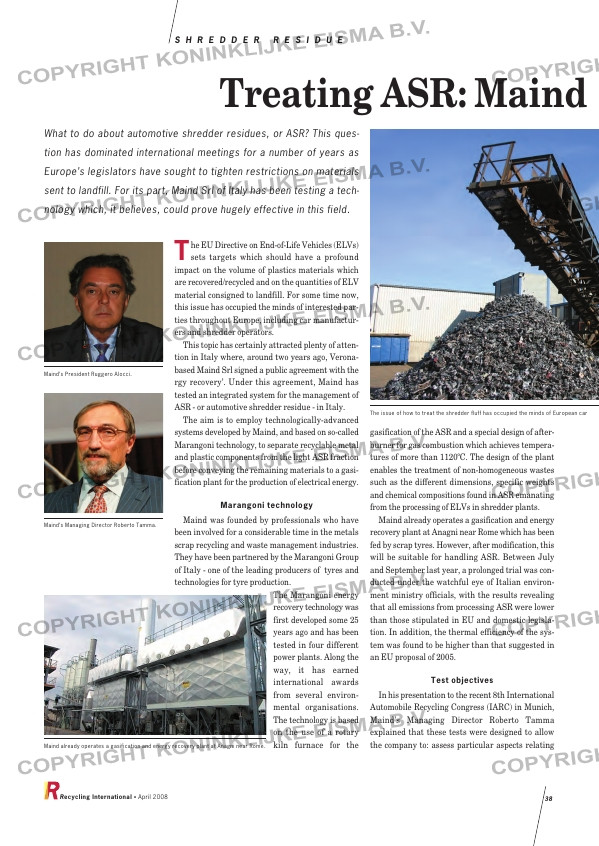Page 38 from: April 2008

T he EU Directive on End-of-Life Vehicles (ELVs)sets targets which should have a profound
impact on the volume of plastics materials which
are recovered/recycled and on the quantities of ELV
material consigned to landfill. For some time now,
this issue has occupied the minds of interested par-
ties throughout Europe, including car manufactur-
ers and shredder operators.
This topic has certainly attracted plenty of atten-
tion in Italy where, around two years ago, Verona-
based Maind Srl signed a public agreement with the
rgy recovery’. Under this agreement, Maind has
tested an integrated system for the management of
ASR – or automotive shredder residue – in Italy.
The aim is to employ technologically-advanced
systems developed by Maind, and based on so-called
Marangoni technology, to separate recyclable metal
and plastic components from the light ASR fraction
before conveying the remaining materials to a gasi-
fication plant for the production of electrical energy.
Marangoni technology
Maind was founded by professionals who have
been involved for a considerable time in the metals
scrap recycling and waste management industries.
They have been partnered by the Marangoni Group
of Italy – one of the leading producers of tyres and
technologies for tyre production.
The Marangoni energy
recovery technology was
first developed some 25
years ago and has been
tested in four different
power plants. Along the
way, it has earned
international awards
from several environ-
mental organisations.
The technology is based
on the use of a rotary
kiln furnace for the
gasification of the ASR and a special design of after-
burner for gas combustion which achieves tempera-
tures of more than 1120ºC. The design of the plant
enables the treatment of non-homogeneous wastes
such as the different dimensions, specific weights
and chemical compositions found in ASR emanating
from the processing of ELVs in shredder plants.
Maind already operates a gasification and energy
recovery plant at Anagni near Rome which has been
fed by scrap tyres. However, after modification, this
will be suitable for handling ASR. Between July
and September last year, a prolonged trial was con-
ducted under the watchful eye of Italian environ-
ment ministry officials, with the results revealing
that all emissions from processing ASR were lower
than those stipulated in EU and domestic legisla-
tion. In addition, the thermal efficiency of the sys-
tem was found to be higher than that suggested in
an EU proposal of 2005.
Test objectives
In his presentation to the recent 8th International
Automobile Recycling Congress (IARC) in Munich,
Maind’s Managing Director Roberto Tamma
explained that these tests were designed to allow
the company to: assess particular aspects relating
S H R E D D E R R E S I D U E
Recycling International • April 2008 38
What to do about automotive shredder residues, or ASR? This ques-
tion has dominated international meetings for a number of years as
Europe’s legislators have sought to tighten restrictions on materials
sent to landfill. For its part, Maind Srl of Italy has been testing a tech-
nology which, it believes, could prove hugely effective in this field.
Treating ASR: Maind
The issue of how to treat the shredder fluff has occupied the minds of European car m
Maind already operates a gasification and energy recovery plant at Anagni near Rome.
Maind’s President Ruggero Alocci.
Maind’s Managing Director Roberto Tamma.
RI_039 ASR Maind:Opmaak 1 03-04-2008 15:22 Pagina 38



